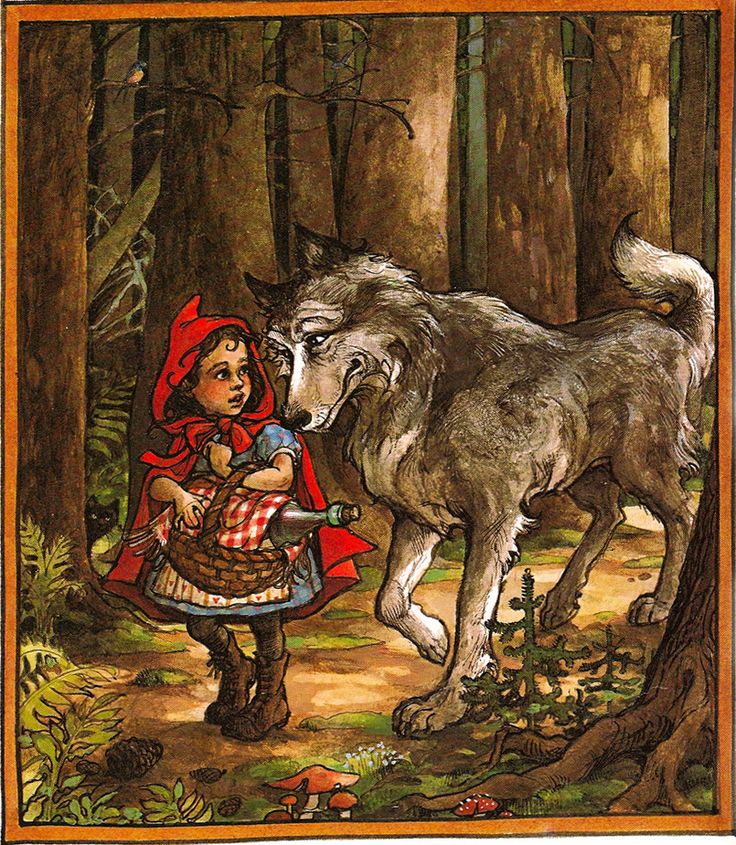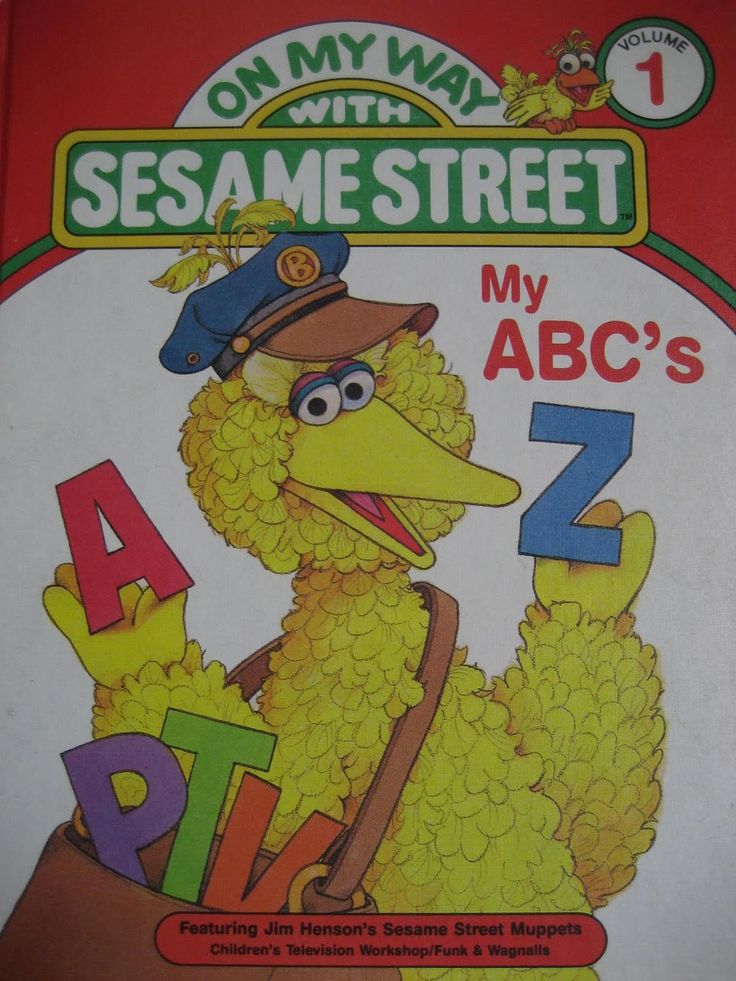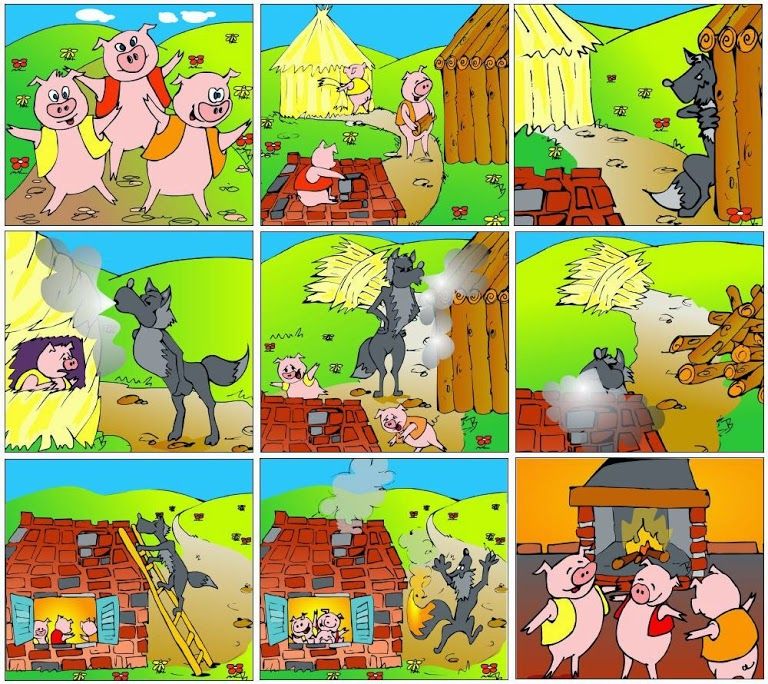All about kangaroos
Kangaroos: Facts, Information & Pictures
Live Science is supported by its audience. When you purchase through links on our site, we may earn an affiliate commission. Here’s why you can trust us.
A kangaroo mother and her joey. (Image credit: <a href="http://www.shutterstock.com/gallery-677161p1.html">Renate</a> | <a href="http://www.shutterstock.com">Shutterstock</a>)Kangaroos are large marsupials that are found only in Australia. They are identified by their muscular tails, strong back legs, large feet, short fur and long, pointed ears. Like all marsupials, a sub-type of mammal, females have pouches that contain mammary glands, where their young live until they are old enough to emerge.
Kangaroos are in the Macropodidae family, which also includes tree-kangaroos, wallabies, wallaroos, quokkas and pademelons. When people think of kangaroos, the four species that typically come to mind are in the genus
Macropus: the antilopine kangaroo, the red kangaroo, the western gray kangaroo and the eastern gray kangaroo. They are sometimes referred to as the "great kangaroos" because these species are much larger than other kangaroos.
However, there are 12 species of tree-kangaroos in the Dendrolagus genus, according to the Integrated Taxonomic Information System. And, bettongs, in the Potoridae family, are called rat-kangaroos.
Size
The largest kangaroo, as well as the largest marsupial, is the red kangaroo, according to National Geographic . The length from the red kangaroo's head to its rump is 3.25 to 5.25 feet (1 to 1.6 meters) long. Its tail adds another 35.5 to 43.5 inches (90 to 110 centimeters) to its length and its entire body weighs around 200 lbs. (90 kilograms).
The smallest kangaroo is the musky rat-kangaroo. It is only 6 to 8 inches (15.24 to 20.32 cm) long and weighs only 12 ounces (340 grams). Its ratlike tail adds another 5 to 6 inches (12.7 to 15.24 cm) to its length.
Habitat
Most kangaroos live on the continent of Australia, though each species has a different place it likes to call home. For example, the musky rat-kangaroo likes to nestle down in little nests on the floor of the rainforests in northeastern Queensland. Gray kangaroos like the forests of Australia and Tasmania, on the other hand. The antilopine kangaroo can be found in the monsoonal eucalyptus woodlands of extreme northern Australia. Tree-kangaroos live in the upper branches of trees in the rainforests of Queensland, as well as on the island of New Guinea.
For example, the musky rat-kangaroo likes to nestle down in little nests on the floor of the rainforests in northeastern Queensland. Gray kangaroos like the forests of Australia and Tasmania, on the other hand. The antilopine kangaroo can be found in the monsoonal eucalyptus woodlands of extreme northern Australia. Tree-kangaroos live in the upper branches of trees in the rainforests of Queensland, as well as on the island of New Guinea.
Habits
Kangaroos are the only large animals that hop as a primary means of locomotion. Their springy hind legs and feet are much stronger and larger than their arms (or "forelimbs"). According to the San Diego Zoo, kangaroos can cover 15 feet (7 m) in a single hop and can hop as fast as 30 mph (48 kph). Usually, 20 mph (32 kph) is considered their cruising speed. When feeding, kangaroos use a slower, walking movement, and for that they use their muscular tail as a kind of fifth leg, pushing off the ground as they move along.
Kangaroos are social and live in groups called a mob, a herd or a troop. Kangaroos in a mob will groom each other and protect each other from danger. If a kangaroo suspects there is danger in the area, it will stomp its foot on the ground to alert others. If it comes to blows, a kangaroo will box and kick its opponent.
Diet
Kangaroos are herbivores. They eat grasses, flowers, leaves, ferns, moss and even insects. Like cows, kangaroos regurgitate their food and re-chew it before it is ready to be totally digested.
A juvenile kangaroo views the outside world from the pouch of an adult female Eastern gray kangaroo. (Image credit: Fir0002/Flagstaffotos)Offspring
Probably the best-known fact about kangaroos is that they carry their young in a pouch. A female kangaroo is pregnant for 21 to 38 days, and she can give birth to up to four offspring at one time, though this is unusual.
At birth, the baby, called a joey, can be as small as a grain of rice, or as big as a bee, at 0. 2 to 0.9 inches (5 to 25 millimeters), according to the San Diego Zoo. When the joey is born, it is guided safely into the comfy pouch, where it gestates for another 120 to 450 days.
2 to 0.9 inches (5 to 25 millimeters), according to the San Diego Zoo. When the joey is born, it is guided safely into the comfy pouch, where it gestates for another 120 to 450 days.
Inside the pouch, the joey is protected and can feed by nursing from its mother's nipples. Joeys urinate and defecate in the mother's pouch. The lining of the pouch absorbs some of the mess, but occasionally the mother will need to clean it out, which she does by inserting her long snout into the pouch and using her tongue to remove the contents. A young joey will remain attached to a nipple while the mother does this, but any older ones will be temporarily kicked out.
Another interesting fact about the mother kangaroo is that she is able to suckle two joeys at different developmental stages at the same time with milk that has different nutritional content, the New York Times has reported.
Joeys grow quickly, though, and at 14 to 20 months for females or 2 to 4 years for males, they will be fully matured.
Classification/taxonomy
The taxonomy of kangaroos, tree-kangaroos and rat-kangaroos, according to ITIS, is:
- Kingdom: Animalia
- Subkingdom: Bilateria
- Infrakingdom: Deuterostomia
- Phylum: Chordata
- Subphylum: Vertebrata
- Infraphylum: Gnathostomata
- Superclass: Tetrapoda
- Class: Mammalia
- Subclass: Theria
- Infraclass: Metatheria
- Order: Diprotodontia
- Suborder: Macropodiformes
'Great kangaroos'
- Family: Macropodidae
- Subfamily: Macropodinae
- Genus & species: Macropus fuliginosus (western gray kangaroo; three subspecies), Macropus giganteus (eastern gray kangaroo; two subspecies), Macropus antilopinus (antilopine kangaroo), Macropus rufus (red kangaroo)
Tree-kangaroos
- Family: Macropodidae
- Subfamily: Macropodinae
- Genus: Dendrolagus
- Species: 12, including Dendrolagus bennettianus (Bennett's tree-kangaroo), Dendrolagus goodfellowi (Goodfellow's tree-kangaroo), Dendrolagus matschiei (Huon tree-kangaroo) and Dendrolagus spadix (Lowlands tree-kangaroo).

Rat-kangaroos
- Family: Potoridae
- Genera & species: Aepyprymnus rufescens (Rufous bettong or Rufous rat-kangaroo), Bettongia (four species of bettongs, or short-nosed rat-kangaroos), Caloprymnus campestris (desert rat-kangaroo)
Musky rat-kangaroos
- Family: Hypsiprymnodontidae
- Genus & species: Hypsiprymnodon moschatus
Kangaroo ancestors
There is a rich fossil record for kangaroo ancestors and ancient relatives; giant kangaroos plodded through the Pleistocene (2.6 million to 11,700 years ago) and the Pliocene (5.3 million to 2.6 million years ago). And about 20 million years ago, tiny ancestors of modern kangaroos and a related group of kangaroos with fangs scurried through dense forests in northwestern Queensland, Australia, a region that is now arid outback.
In a study published in February 2016, scientists described a new kangaroo genus, Cookeroo, and two new species: Cookeroo bulwidarri, dated to about 23 million years ago, and Cookeroo hortusensis, which lived between 18 million and 20 million years ago.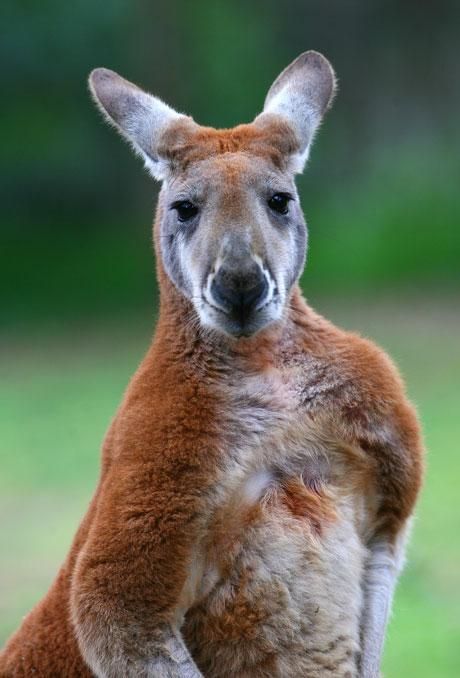 These ancient kangaroos' bodies probably measured about 17 to 20 inches (42 to 52 centimeters) long. C. bulwidarri and C. hortusensis didn't hop, navigating their forest home on all fours and sharing it with a diverse collection of animals: marsupial moles, feather-tailed possums, ancient koalas and crocodiles.
These ancient kangaroos' bodies probably measured about 17 to 20 inches (42 to 52 centimeters) long. C. bulwidarri and C. hortusensis didn't hop, navigating their forest home on all fours and sharing it with a diverse collection of animals: marsupial moles, feather-tailed possums, ancient koalas and crocodiles.
According to the IUCN's Red List of Threatened Species, 16 species of tree-kangaroos and rat-kangaroos are listed as either near threatened, threatened, vulnerable, endangered or critically endangered. The desert rat-kangaroo and the Nullarbor dwarf bettong are considered extinct. Studies show that global warming could also kill off the world's smallest kangaroo. The four species of great kangaroos are not endangered.
Additional resources
- Nature PBS: Kangaroo Facts
- National Geographic: Gray Kangaroos
- University of Michigan: Musky Rat-Kangaroo
- Australian Department of Foreign Affairs and Trade
Alina Bradford is a contributing writer for Live Science. Over the past 16 years, Alina has covered everything from Ebola to androids while writing health, science and tech articles for major publications. She has multiple health, safety and lifesaving certifications from Oklahoma State University. Alina's goal in life is to try as many experiences as possible. To date, she has been a volunteer firefighter, a dispatcher, substitute teacher, artist, janitor, children's book author, pizza maker, event coordinator and much more.
Over the past 16 years, Alina has covered everything from Ebola to androids while writing health, science and tech articles for major publications. She has multiple health, safety and lifesaving certifications from Oklahoma State University. Alina's goal in life is to try as many experiences as possible. To date, she has been a volunteer firefighter, a dispatcher, substitute teacher, artist, janitor, children's book author, pizza maker, event coordinator and much more.
kangaroo | Characteristics, Habitat, Diet, & Facts
kangaroo
See all media
- Related Topics:
- rat kangaroo wallaby Macropus boomer nail-tailed wallaby
See all related content →
Summary
Read a brief summary of this topic
Observe a kangaroo (a marsupial) carrying its joey and feeding and moving about in its natural habitat
See all videos for this articlekangaroo, any of six large species of Australian marsupials noted for hopping and bouncing on their hind legs. The term kangaroo, most specifically used, refers to the eastern gray kangaroo, the western gray kangaroo, and the red kangaroo, as well as to the antilopine kangaroo and two species of wallaroo (see below). Less specifically, kangaroo refers to all 14 species in the genus Macropus, some of which are called wallabies. In its broadest usage, kangaroo refers to any member of the family Macropodidae, which comprises about 65 species, including tree kangaroos and the quokka; rat kangaroos are classified into “sister” familes, Potoroidae and Hypsiprymnodontidae. The Macropodidae are found in Australia (including Tasmania and other offshore islands, such as Kangaroo Island), New Guinea, and the islands east to the Bismarck Archipelago. Several species have been introduced into New Zealand.
The term kangaroo, most specifically used, refers to the eastern gray kangaroo, the western gray kangaroo, and the red kangaroo, as well as to the antilopine kangaroo and two species of wallaroo (see below). Less specifically, kangaroo refers to all 14 species in the genus Macropus, some of which are called wallabies. In its broadest usage, kangaroo refers to any member of the family Macropodidae, which comprises about 65 species, including tree kangaroos and the quokka; rat kangaroos are classified into “sister” familes, Potoroidae and Hypsiprymnodontidae. The Macropodidae are found in Australia (including Tasmania and other offshore islands, such as Kangaroo Island), New Guinea, and the islands east to the Bismarck Archipelago. Several species have been introduced into New Zealand.
Form and function
Common features
With the exception of tree kangaroos (genus Dendrolagus), all members of the kangaroo family (Macropodidae) rely on long, powerful hind legs and feet for hopping and leaping, their predominant forms of locomotion. Their long tails, thickened at the base, are used for balancing. This feature is most obvious in the large kangaroos, which use the tail as a third leg when standing still. Each long, narrow hind foot has four toes, the large fourth toe bearing most of the animal’s weight. The second and third toes are united and merely vestigial, a condition known as syndactyly. The short forelimbs, having five unequal digits, are used almost like human arms, but all digits of the “hand” are sharp-clawed, and the thumb is not opposable. The head is relatively small; the ears are (in most macropodids) large and rounded; and the mouth is small, with prominent lips. The pelage is generally soft and woolly; in many species it is grizzled, and stripes may be present on the head, back, or upper limbs. All macropodids are herbivorous and have a chambered stomach that is functionally similar to those of such ruminants as cattle and sheep. Ecologically, they occupy the niche filled elsewhere by grazing and browsing animals (larger species tend to be grazers, smaller ones browsers).
Their long tails, thickened at the base, are used for balancing. This feature is most obvious in the large kangaroos, which use the tail as a third leg when standing still. Each long, narrow hind foot has four toes, the large fourth toe bearing most of the animal’s weight. The second and third toes are united and merely vestigial, a condition known as syndactyly. The short forelimbs, having five unequal digits, are used almost like human arms, but all digits of the “hand” are sharp-clawed, and the thumb is not opposable. The head is relatively small; the ears are (in most macropodids) large and rounded; and the mouth is small, with prominent lips. The pelage is generally soft and woolly; in many species it is grizzled, and stripes may be present on the head, back, or upper limbs. All macropodids are herbivorous and have a chambered stomach that is functionally similar to those of such ruminants as cattle and sheep. Ecologically, they occupy the niche filled elsewhere by grazing and browsing animals (larger species tend to be grazers, smaller ones browsers). Several smaller species have become extinct or are gravely endangered, probably because of predation by introduced foxes. The wedge-tailed eagle (Aquila audax) is one of the macropodids’ few natural predators.
Several smaller species have become extinct or are gravely endangered, probably because of predation by introduced foxes. The wedge-tailed eagle (Aquila audax) is one of the macropodids’ few natural predators.
Reproduction and development
In all species, the marsupium (or pouch) is well developed, opens forward, and contains four teats. The young kangaroo (“joey”) is born at a very immature stage, when it is only about 2 cm (1 inch) long and weighs less than a gram (0.04 ounce). Immediately after birth, it uses its already clawed and well-developed forelimbs to crawl up the mother’s body and enter the pouch. The joey attaches its mouth to a teat, which then enlarges and holds the young animal in place. After continuous attachment for several weeks, the joey becomes more active and gradually spends more and more time outside the pouch, which it leaves completely at 7 to 10 months of age.
Female macropodids of many species enter into heat within a few days after giving birth, mating and conception thus occurring while the previous offspring is still in the pouch. After only one week’s development, the microscopic embryo enters a dormant state, called diapause, that lasts until the first joey begins to leave the pouch or until conditions are otherwise favourable. The development of the second embryo then resumes and proceeds to birth after a gestation period of about 30 days. Therefore, the teats are for a while feeding young of very different developmental stages, during which time different teats produce two different compositions of milk. This is thought to be an adaptation for recovering population numbers quickly after a drought, when breeding ceases and the diapause state is prolonged. In the gray kangaroos, which live in wooded country with a more predictable environment, this system does not exist; there is no diapause, and the pouch is occupied by one young at a time.
After only one week’s development, the microscopic embryo enters a dormant state, called diapause, that lasts until the first joey begins to leave the pouch or until conditions are otherwise favourable. The development of the second embryo then resumes and proceeds to birth after a gestation period of about 30 days. Therefore, the teats are for a while feeding young of very different developmental stages, during which time different teats produce two different compositions of milk. This is thought to be an adaptation for recovering population numbers quickly after a drought, when breeding ceases and the diapause state is prolonged. In the gray kangaroos, which live in wooded country with a more predictable environment, this system does not exist; there is no diapause, and the pouch is occupied by one young at a time.
Britannica Quiz
Mammalian Matters: Fact or Fiction?
Will big horns sink a water buffalo? Is the vampire bat’s thirst for blood bigger than the bat itself? And do orangutans live in Africa? The facts about mammals come out in this quiz.
Dentition
The larger species of kangaroos have complex, high-crowned teeth. The four permanent molars on each side of both jaws erupt in sequence from front to back and move forward in the jaw, eventually being pushed out at the front. Thus, an old kangaroo may have only the last two molars in place, the first two (and the premolar) having long since been shed. The molars possess cross-cutting ridges, so that tough grass is sheared between opposing teeth. The molars of smaller macropodids are much simpler. The large kangaroos continue growing throughout life, especially the males (most markedly in the red kangaroo), whereas the smaller macropodids do not.
description, views, interesting facts (photo)
78 105 4.27 9
Kangaroos are the best jumpers of our planet: the length of one jump is three meters in height and about twelve in length. They move in huge leaps at a speed of about 50 km / h, pushing off the surface with strong hind legs, while an important role is played by the tail, which plays the role of balance and helps to maintain balance.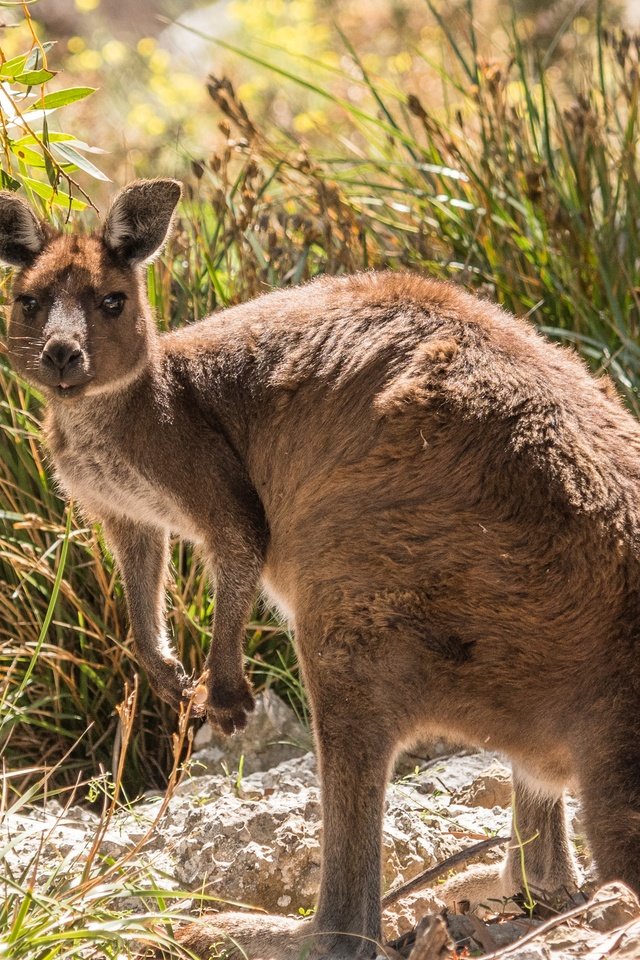
Therefore, it is impossible to catch up with the animal, especially since during the flight it is capable of anything: once a large red kangaroo, running away from the farmers, jumped over a three-meter fence. If someone who wants to eat kangaroo meat is lucky enough to overtake him, the marsupial will use its hind legs. To do this, it will transfer the entire weight of the body to the tail, and freeing both hind legs, inflict terrible wounds on the enemy.
Contents:
- 1 Symbol of Australia
- 2 Description
- 3 Lifestyle
- 4 Relationships with people
Symbol of Australia
Kangaroos are called marsupial mammals from the group of two-cutters (they have two large incisors on the lower jaw). This word is used in two meanings:
- Apply in a broad aspect to all representatives of the kangaroo family, and this is from 46 to 55 species. It includes a family of herbivores that move by jumping, have undeveloped forelegs, and vice versa, extremely developed hind legs, and also have a strong tail that helps to maintain balance while moving.
Because of this structure, the body of the animals is in an upright position, while leaning on the tail and hind legs. Thus, three species are distinguished: kangaroo rats are the smallest individuals; wallabies - are of medium size, outwardly resemble a smaller copy of large animals; large kangaroos are the marsupials of Australia.
- They call the largest representatives of marsupials from the long-legged family, which are an unofficial symbol of Australia: they can be seen on the coat of arms, coins.
Representatives of the family live both in arid regions and tropical forests in Australia, Tasmania, New Guinea, on the Bismarck Islands. At the end of XIX - beginning of XX century. they took root well in Germany and England, successfully bred and even endured snowy winters well, but they were powerless against poachers, who completely exterminated them.
Description
Depending on the species, members of the family have a length of 25 cm (plus 45 cm - tail) to 1. 6 m (tail - 1 m), and weigh from 18 to 100 kg. The largest individual is considered to be a resident of the Australian continent - a large red kangaroo, and the heaviest - an eastern gray kangaroo. The fur of marsupials is soft, thick, it can be gray, black, red colors and their shades.
6 m (tail - 1 m), and weigh from 18 to 100 kg. The largest individual is considered to be a resident of the Australian continent - a large red kangaroo, and the heaviest - an eastern gray kangaroo. The fur of marsupials is soft, thick, it can be gray, black, red colors and their shades.
Kangaroo animal is interesting because its upper part is poorly developed. The head is small, the muzzle can be both long and shortened. The shoulders are narrow, the front legs are short, weak, hairless, have five fingers, but are armed with very sharp claws. The fingers are very mobile and the animal uses them for grasping, feeding, combing wool.
But the lower part of the body is developed: the hind legs, a long thick tail, the hips are very strong, they have four fingers on the foot, while the second and third are connected by a membrane, the fourth has a strong claw.
Such a structure makes it possible to successfully defend with the help of powerful blows with the hind legs, and move quickly (with the tail replacing the steering wheel of the marsupial).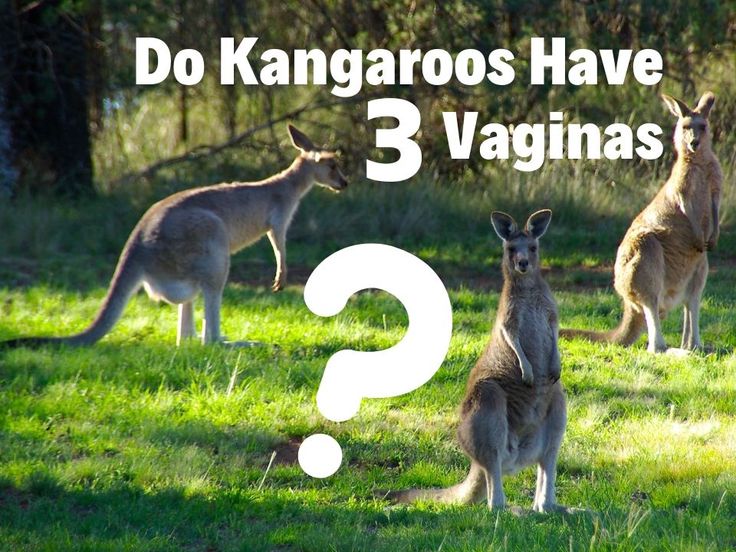 These animals are unable to move backward - this is not allowed by their too large tail and the shape of the hind legs.
These animals are unable to move backward - this is not allowed by their too large tail and the shape of the hind legs.
Lifestyle
Marsupials prefer to be nocturnal, appearing on pastures at dusk. During the day, they rest in burrows, nests made of grass, or in the shade of trees.
If one of the animals notices any danger (for example, a dingo dog wanted to taste kangaroo meat), the message about this is immediately transmitted to the rest of the pack by hitting the hind legs on the ground. To transmit information, they often use sounds - grunting, sneezing, clicking, hissing.
If favorable conditions for living are observed in the area (abundance of food, absence of danger), marsupials may well form a large community of one hundred individuals. But, usually they live in small flocks, which consist of a male, several females and kangaroos growing up in a bag. At the same time, the male very jealously guards the flock from other males, and if they try to join, fierce fights occur.
These animals are characterized by attachment to a certain territory, and they prefer not to leave it without special reasons (the exception is the huge red kangaroos, which are able to overcome several tens of kilometers in search of the best food sites).
Despite the fact that marsupials are not particularly smart, they are very resourceful and able to adapt well: if their usual food ceases to be enough, they switch to other foods, while eating plants that even animals that are not picky in food do not eat (for example, dry, tough and even thorny grass).
Food
Marsupials feed on leaves of trees and shrubs, bark, roots, shoots, some species hunt insects and worms. They either dig food or cut it with their teeth, while it is worth noting that they usually have no upper fangs at all, or they are poorly developed, but there are two large incisors on the lower jaw (another interesting fact is that they, in unlike most mammals, teeth are constantly changing).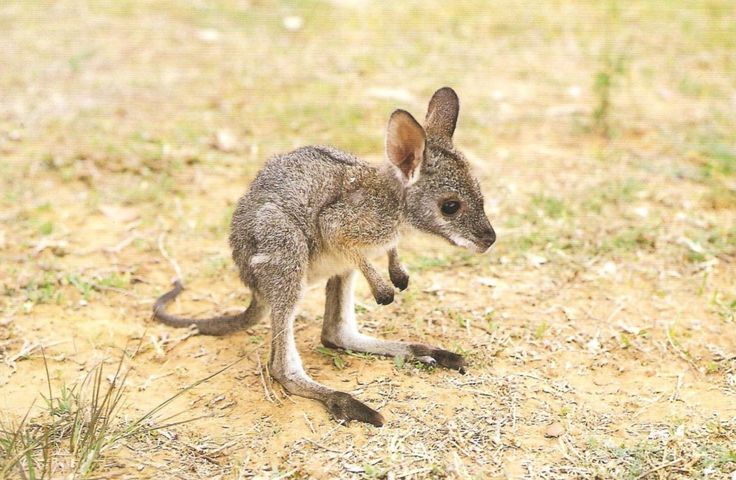
Marsupials are very well adapted to drought, so they can do without water for several days or even months (they take most of the liquid from plant foods).
If they still feel very thirsty, they dig a well a meter deep with their paws and get to the precious moisture (along the way, helping other animals suffering from lack of water). At this time, they try not to waste energy: during the drought months, they move less and spend more time in the shade.
Reproduction
The ability to reproduce offspring begins as early as one and a half to two years (they live from 9 to 18 years, there were cases when individual specimens lived to be thirty). At the same time, the males are fighting so fiercely for the female that the collision often ends in severe injuries.
The female is born mainly only one kangaroo cub, less often - twins. Before the baby is born, the mother carefully licks the pouch (a leather fold on the abdomen intended for the development of the baby kangaroo) and cleans it.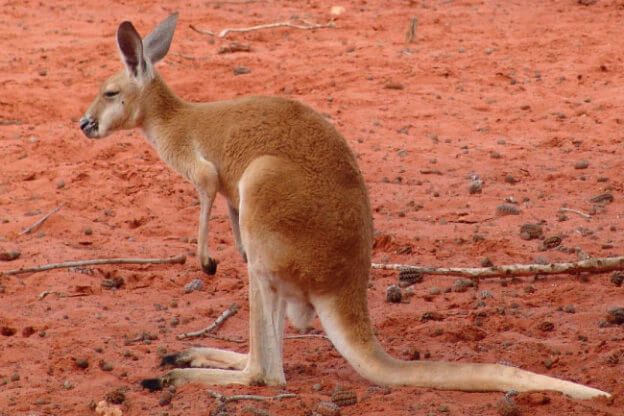
Pregnancy lasts from one to one and a half months, so the kangaroo cub is born blind, without hair, its weight does not exceed one gram, and its length is no more than three centimeters in large species. As soon as he is born, he instantly clings to his mother's wool and crawls into a bag in which he spends about eleven months.
In the bag, he immediately grasps one of the four nipples and does not tear himself away from it for two and a half months (at the initial stage he is not yet able to suck milk, the liquid is secreted by itself under the influence of a special muscle). By this time, the baby develops, grows up, begins to see clearly, becomes overgrown with fur and begins to leave the shelter for a short time, while he is very alert and jumps back at the smallest sound.
After the kangaroo begins to leave the pouch for a long time (at the age of 6 to 11 months), the mother gives birth to the next cub. Interestingly, the female is able to delay the birth of a kangaroo cub until the previous baby leaves the bag (it is either still too small, or there are adverse weather conditions, such as drought). And then, in case of danger, he will be in the shelter for several more months.
And then, in case of danger, he will be in the shelter for several more months.
And here an interesting picture is observed when the female begins to produce two types of milk: from one nipple, the already grown cub receives more fat milk, from the other, the newborn eats milk with a lower fat content.
Relations with people
In nature, a large kangaroo has few enemies: kangaroo meat attracts only foxes, dingoes and birds of prey (and even then, marsupials are quite capable of protecting themselves with the help of their hind legs). But relations with humans are tense: pastoralists, not without reason, accuse them of spoiling crops on pastures, and therefore shoot them or scatter poisonous baits.
In addition, most of the species (only nine are protected by law) are allowed to be hunted to regulate their numbers: kangaroo meat, which contains a huge amount of protein and only 2% fat. It is worth noting that kangaroo meat has long been one of the main sources of food for the natives. Animal skins are used to make clothes, shoes and other products. Animals are often hunted for sport, so many species are found only in uninhabited areas
It is worth noting that kangaroo meat has long been one of the main sources of food for the natives. Animal skins are used to make clothes, shoes and other products. Animals are often hunted for sport, so many species are found only in uninhabited areas
Kangaroos -
There are many unusual and mysterious animals in Australia, and a special place among them is occupied by kangaroos, or rather, the kangaroo family, which includes large and medium kangaroos , wallara and wallaby. There are also kangaroo rats, small animals similar to wallabies, but this is an independent family in the suborder Macropodiformes of the order of Dictate marsupials, which includes kangaroos.
The most famous features of the kangaroo are the presence of a pouch for carrying cubs and a characteristic way of movement, jumping, which allows you to move quickly and overcome various obstacles. Someone, perhaps, will remember the difficult nature of the kangaroo, leading to skirmishes and fights of adult males. But in fact, these animals still have many differences and unusual features. Some of their secrets are still a mystery to scientists.
But in fact, these animals still have many differences and unusual features. Some of their secrets are still a mystery to scientists.
This article does not promise a complete set of encyclopedic knowledge about the kangaroo, but is intended to tell in detail about this animal, the myths associated with it, as well as interesting facts about the kangaroo.
Appearance
Firstly, the kangaroo family is very diverse and includes more than 50 species from the smallest, up to 30 cm tall, to giant animals over 1.5 meters, reaching a weight of 90 kg. The largest members of the family are gray and red (red) kangaroos, some males of which grow up to 3 meters and weigh up to 100 kg. The physique of all members of the family is similar - powerful developed hind legs, a thick tail and small, human-like hands. The appearance determined the characteristic way of movement - springy jumps on the hind legs. Jumps of some adults reach 12 meters in length and 3 meters in height, in case of danger, kangaroos reach speeds of up to 60 km / h. A thick tail during the jump serves as a balancer, and in a calm state - an additional support, standing on its hind legs and using the tail of a kangaroo, they keep the body in an upright position. In case of danger, kangaroos inflict strong blows with their hind legs, often breaking the bones of the attacking animal. The front, underdeveloped paws with sharp claws are used to dig up roots and succulent stems.
A thick tail during the jump serves as a balancer, and in a calm state - an additional support, standing on its hind legs and using the tail of a kangaroo, they keep the body in an upright position. In case of danger, kangaroos inflict strong blows with their hind legs, often breaking the bones of the attacking animal. The front, underdeveloped paws with sharp claws are used to dig up roots and succulent stems.
Kangaroos cannot move backwards. The Australians noticed this and, together with the emu, which also cannot walk backwards, placed a kangaroo on the unofficial part of the Australian coat of arms above the motto "Australia, forward!", thus symbolizing the progress, the movement only forward, followed by the country.
Habitat
Kangaroos, the largest marsupial mammals, live in Australia, Tasmania and New Guinea, and also introduced to New Zealand. Kangaroos have good eyesight, but they only react to moving objects; they also have excellent hearing, turning their large ears in all directions to pick up subtle sounds. Thick long eyelashes protect their eyes from dust. Wide molars are ideally suited for chewing plant foods, and chewing teeth in kangaroos are updated as they wear out. If all 4 pairs laid down by nature are erased, the animal will suffer from hunger and exhaustion.
Thick long eyelashes protect their eyes from dust. Wide molars are ideally suited for chewing plant foods, and chewing teeth in kangaroos are updated as they wear out. If all 4 pairs laid down by nature are erased, the animal will suffer from hunger and exhaustion.
Most species of kangaroos live on plains, among tall grass and bushes. In a similar environment, they can be observed in the Maru Game Reserve on Phillip Island. These are predominantly nocturnal animals, during the day they prefer to hide in shelters. Kangaroos build their nests out of grass or dig small holes. Mountain wallabies and eastern wallaroo live in hard-to-reach rocks. Their paws with a rough surface are well suited for climbing slippery stones, during the day they take refuge in caves or dig holes for themselves in which they stand. These species can be found in the Granite Gorge on an excursion to the Atherton Plateau. Tree kangaroos have adapted to climb trees - they sleep on boughs, climb and crawl along branches, and are able to jump from a height of 20 meters; but for food, roots, berries and leaves, they descend to the ground. In their natural environment, tree kangaroos can be seen in Queensland on excursions from Cairns.
In their natural environment, tree kangaroos can be seen in Queensland on excursions from Cairns.
An amazing feature of kangaroos is that they can go without water for a long time, sometimes for months. They take water from plants, sometimes during dry periods, peel off the bark of trees and lick the juice. Suffering from the heat, kangaroos lick the skin, cooling in this way, but they drink water in extremely rare cases.
Kangaroos are social animals, they live both in small groups, consisting of a male with several females and cubs, and in large flocks of up to 100 kangaroos. In case of danger, kangaroos warn their fellow tribesmen by tapping their paws on the ground. Only mountain kangaroos, wallaroo, prefer to live alone. Old male wallaroos are also very aggressive. If other types of large kangaroos do not attack themselves, preferring to run away from danger, and use their special fighting techniques - claws and powerful kicks as protection, then wallaras are very pugnacious.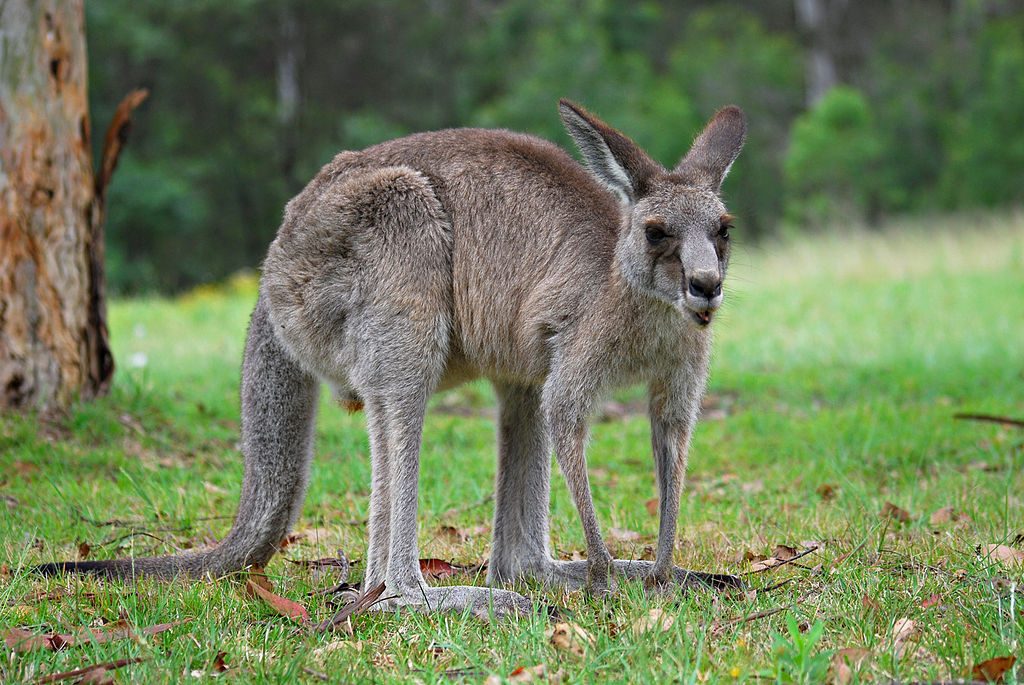 Vallarus scratch and bite, but surprisingly, they never use their strongest tool - their legs. Why is a mystery! In Australia, kangaroo fights are widespread, they are arranged as entertainment for tourists, and for the inhabitants of the country this is a whole industry with bets on the sweepstakes.
Vallarus scratch and bite, but surprisingly, they never use their strongest tool - their legs. Why is a mystery! In Australia, kangaroo fights are widespread, they are arranged as entertainment for tourists, and for the inhabitants of the country this is a whole industry with bets on the sweepstakes.
Features of reproduction
Another amazing feature of kangaroos is their breeding system. Like all marsupials, their cubs are born very premature and are finally formed in their mother's pouch. But, a new kangaroo cub appears every year, as soon as the previous one finally leaves the bag. It turns out that immediately after birth, and at the marsh wallaby the day before, female kangaroos mate. The new embryo freezes in development and remains in this state until a certain “signal” - the bag is released. Thus, a caring mother can have 3 cubs at the same time - one adult who has just left the pouch, the second growing up in the pouch and the third - the embryo in pause mode.
By the way, only the female kangaroo has a pouch, and she controls it using special muscles. Thus, the mother herself decides when to release the cub into the wild. When swimming, these muscles reliably protect the cub, so that not a single drop of water seeps inside. Inside the bag there are 4 nipples, each of which produces milk that differs in composition, which is required at different age periods of the cub. If a mother has 2 babies of different ages, then each will receive their own milk, which is required for development. Previously, there was an opinion that the cubs were immediately born in the bag, but in fact, a tiny born, completely unformed baby crawls into the bag along a path licked in fur and clings to the nourishing nipple. He can’t suck himself yet, so the mother, controlling the muscles of the nipple, injects milk, the nipple swells and wedges in the baby’s mouth. In such a "suspended" position, the cub will be until it grows up.
Kangaroos are also very loving and caring mothers. Not only do they feed and protect already grown cubs, they let them into their bag in case of danger or simply when they need their mother's warmth, even if the younger brother is already growing in the bag. During the attack, leaving the chase, the female imperceptibly throws the cub out of the bag into the bushes or tall grass, saving him from persecution and diverting attention to herself. Later, she will definitely return for him if she herself manages to escape.
Not only do they feed and protect already grown cubs, they let them into their bag in case of danger or simply when they need their mother's warmth, even if the younger brother is already growing in the bag. During the attack, leaving the chase, the female imperceptibly throws the cub out of the bag into the bushes or tall grass, saving him from persecution and diverting attention to herself. Later, she will definitely return for him if she herself manages to escape.
Natural enemies
Kangaroos have few natural enemies in nature. Young kangaroos of small species are attacked by dingoes, foxes or birds of prey. After the extermination of the main enemy of the kangaroo, the marsupial wolf, there were no serious opponents. Most of all they are bothered by sand flies, swarming in clouds near water bodies. Insects bite animals, stick to the eyes and often lead to blindness.
Kangaroo populations vary by species. Larger species have grown exponentially in recent years, and it is estimated that there are now three times as many kangaroos in Australia as there are people.



